When creating a planted tank, selecting the right variety of plants and placing them in a strategic manner can have a significant impact on the overall appearance of the tank. It is a common practice to place taller plants towards the back and shorter ones in the front to create a sense of depth. However, having a stark height contrast can sometimes create an unappealing visual effect.
To address this issue, aquascapers often incorporate medium-sized plants in the middle ground. These plants act as a bridge between the foreground and background, providing a smoother transition in height. This approach not only enhances the tank’s appearance but also adds a natural feel to it, similar to the layered growth seen in natural habitats.
For example, imagine two tanks: one with only short and tall plants, and the other with a mix of short, medium, and tall plants. In the latter, the addition of medium-sized plants creates a more balanced and visually pleasing composition. The eye is guided from the front to the middle and then to the back, resulting in a harmonious display reminiscent of natural underwater landscapes.
By incorporating this technique, aquascapers also elevate their aquascaping skills, creating captivating underwater scenes that capture the beauty of nature.
To help you get started, let us introduce you to our some of our categories of mid-ground plants, paludarium-plants, foreground-plants that will enhance the beauty of your planted aquarium:
Mid-ground plants
Java Fern

Java fern (Microsorum pteropus) is a versatile and visually appealing plant that can enhance any planted tank. Its medium-sized leaves and affinity for attaching to wood and rocks make it ideal for midground placement. The ‘Windelov’ variety offers a unique texture and remains more compact, making it suitable for midground placement even in smaller aquascapes. Both varieties are easy to care for and popular among hobbyists.
Crypt lucens

Cryptocoryne lucens is a stunning midground plant with narrow leaves that create a graceful texture transition from foreground to background in an aquarium. It forms dense clusters and is undemanding, making it a valuable addition to any aquascape. Its delicate foliage and graceful growth pattern make it a standout choice for creating captivating underwater landscapes.
Paludarium Plants
- Bacopa Species

Bacopa caroliniana is a versatile plant that can thrive in various environments, making it an ideal choice for paludarium setups. Although it can grow submerged, its stems tend to grow above the water surface over time. Interestingly, Bacopa species can also flourish in soil as long as they receive regular watering and are not allowed to dry out for extended periods. What makes Bacopa particularly appealing is its ease of cultivation.
Unlike some plants, it doesn’t require high humidity or intense lighting to thrive. Its low-maintenance nature makes it accessible to aquarists and terrarium enthusiasts alike. Observing the delicate flowers that Bacopa produces can be a rewarding experience, especially in a paludarium setup where both aquatic and terrestrial elements are present. Whether grown in soil or submerged, Bacopa adds visual interest and natural beauty to any environment, making it a valuable addition to any aquascape or terrarium.
Java Moss and Other Mosses

Java moss, which is reminiscent of the lush moss-covered trees and rocks found in woodland settings, can thrive beyond the confines of aquariums. This plant demands high humidity and consistent moisture, but it can be a striking addition to moist terrestrial environments. Java moss has a propensity to spread and cover surfaces, creating a soft, verdant carpet that adds a touch of natural beauty.
One of the remarkable characteristics of Java moss is its adaptability to grow partially submerged. This trait allows it to thrive in environments where water meets land, contributing to a visually appealing effect. Whether draped over rocks, logs, or soil, Java moss adds a sense of tranquility and natural charm to its surroundings. Incorporating Java moss into moist terrestrial setups offers an opportunity to create captivating landscapes that are reminiscent of forest floors or tranquil streams. Its ability to flourish in such environments adds versatility to its use in aquascaping and terrarium projects, enhancing the overall aesthetic appeal with its lush greenery.
Brazilian Pennywort

Brazilian pennywort is a plant that can be grown under or above water. When grown underwater, it develops umbrella-shaped leaves that provide a shaded area for aquarium inhabitants.
When grown above water, its leaves become denser, and its stems form a bushy greenery that provides a shelter for small creatures. Regular trimming is essential, as it is a fast-growing plant that can spread rapidly.
Despite its tendency to proliferate, Brazilian pennywort remains a great addition to any aquascape or terrarium, offering both aesthetic beauty and functional benefits.
Anubias

Anubias is a plant that typically grows well in semi-aquatic environments, often found growing in terrestrial soil along riverbanks or streams. Although it prefers to avoid being excessively dry, species within the Anubias genus can flourish outside of aquariums in high humidity environments with ample water. They are easy to grow and have a slow and steady growth rate.Combining Anubias with mosses in a planted setup not only creates a beautiful aesthetic but also has practical benefits. Mosses help maintain moisture around the roots of Anubias, fostering a symbiotic relationship that enhances the overall health and vitality of both plants. This charming pairing adds visual appeal and promotes mutual well-being in the planted environment.
Scarlet Temple

Consider adding scarlet temple, also known as Alternanthera reineckii, to your terrarium or humid container setup for a vibrant and colorful option. Although not typically grown outside, this plant thrives in high humidity environments with accessible water, and is well-suited for terrestrial growth.
Scarlet temple displays its striking pinkish-red leaves whether grown submerged or outside of water, making it an eye-catching centerpiece or accent plant to add a splash of color to any green backdrop. Its beauty isn’t just for show either; scarlet temple is known to brighten up its surroundings with its vivid hues. Interestingly, it’s not uncommon for scarlet temple plants to be cultivated out of water in plant farm facilities before being distributed to end users. This underscores its adaptability to different growing conditions and its popularity among plant enthusiasts seeking to enhance their indoor landscapes with its vibrant presence.
Foreground Plants
Cryptocoryne Plants

Crypts are low-maintenance foreground plants in aquariums that grow slowly and adapt well to different lighting conditions. C. parva and C. lucens are popular species due to their compact size. Bury the roots in the substrate and keep the crown uncovered when adding a new crypt.
Enriched substrate or root tab fertilizers are essential for their growth. Baby plantlets may grow on established crypts. Crypt melting can be a potential issue. Crypts are a great choice for aquarists seeking a visually appealing yet low-maintenance addition to their tank.
Grass-Like Plants
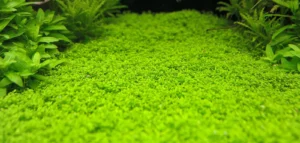
Stoloniferous plants with narrow, grass-like leaves are great for creating a green underwater “lawn” in your aquarium. Carefully separate and plant them in the substrate, and provide nutrient-rich substrate or use root tabs to encourage rapid growth. Regular trimming or higher light levels may be needed to maintain a denser appearance. Dwarf hairgrass, micro sword, and dwarf chain sword are some popular species. By planting them strategically, you can create a vibrant and verdant underwater landscape.Epiphyte Plants

Epiphyte plants, also called rhizome plants, are resilient under low light and thrive without substrate. Anubias nana petite and Bucephalandra “green wavy” are popular species. Attach them to rocks or driftwood with super glue gel. Push the rhizome and roots into the substrate and gently pull up for foreground elements. No need for specialized substrates or extensive maintenance. Great for all skill levels.
Some very Best Background Plants for Beginner Aquariums
Add tall aquarium plants to the back wall to transform your fish tank into a natural beauty. Here are some beginner-friendly plants that grow over 12 inches (30 cm). Many of these plants are grown above water and may wilt when introduced to your aquarium, but don’t worry. Give them 2-4 weeks, and they’ll sprout new leaves and thrive underwater.
Vallisneria
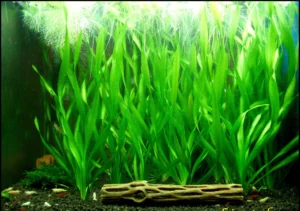
Vallisneria spiralis, also known as “one-plant wonder”, can transform your fish tank into a field of tall grasses that sway gently in the current. Even in low to medium light, it easily grows new shoots that can quickly fill your tank. It is an ideal plant to obscure line of sight when keeping aggressive fish like African cichlids. For a thicker, taller version, consider using jungle val or Vallisneria americana.
Pogostemon stellatus ‘octopus’
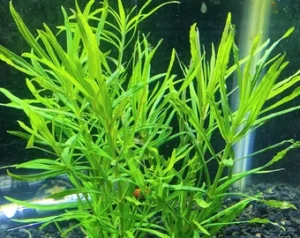
The “Octopus” plant is a unique specimen with a distinctive appearance. It fills out vast areas of your aquarium and provides shelter for shy fish and their offspring. Propagating it is easy; simply trim the top half and replant it deeply into the substrate. The trimmed portion will establish itself as a new individual and continue its growth from the point of pruning. This captivating plant adds visual allure and functional benefits to your aquarium.
Water sprite
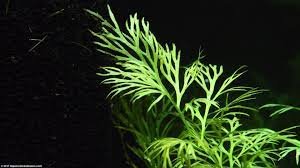
Water sprite (Ceratopteris thalictroides) is an excellent choice for those who want to increase the survival rate of their fish fry. It has dense growth and yellow-green leaves that provide ideal hiding spots for fry, protecting them from adult fish. Water sprite’s rapid growth rate also helps in water purification by absorbing the nitrogen compounds produced by fish waste.
Water sprite is versatile and can be grown either rooted in the substrate or allowed to float at the water surface. This flexibility makes it suitable for a variety of aquarium setups and allows aquarists to customize their tank’s appearance to suit their preferences. Overall, water sprite is a valuable asset to any aquarium. It not only provides protection for fish fry but also contributes to water quality maintenance through its vigorous growth and nutrient-absorbing capabilities.
Amazon sword

Amazon swords are popular aquarium plants with broad leaves that can grow into impressive bush-like formations. They primarily derive nutrients from their roots, so it is crucial to provide them with nutrient-rich substrates or fertilizers. As they mature, they may produce side shoots that develop into new plantlets.The red flame sword variety provides an excellent option for enthusiasts seeking to add a splash of color to their planted tanks, with its green, red, and bronze mottled leaves offering a striking contrast to traditional Amazon swords.
Pearl weed

Hemianthus micranthemoides is a versatile plant for aquariums, with slender stems and oblong leaves. It can be placed in foreground or background depending on trimming. When grown in medium to high light, it forms a dense mass, providing shelter for fish, shrimp, and fry. It can be propagated easily by snipping longer ends and replanting in the substrate.Alternanthera reineckii var. ‘roseafolia’

Scarlet Temple is a short but striking aquarium plant with vibrant pink and red-colored leaves that add a captivating contrast to the predominantly green foliage. It thrives under medium to high light conditions, and brighter lighting intensifies its deep reds and purples. To ensure optimal growth and vibrant coloration, provide it with quality nutrients such as Easy Green and Easy Iron.Tiger lotus
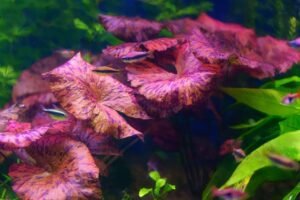
Nymphaea zenkeri, popularly known as tiger lotus, is a magnificent plant that is highly admired for its stunning red and green leaves. It can make for a striking centerpiece in any aquarium due to its visual allure. The plant produces large variegated leaves underwater while sending up elegant lily pads to the water’s surface, adding to its beauty.
When planting your tiger lotus, it is crucial to position the bulb correctly. Ideally, the bulb should be placed on top of or partially buried halfway into the substrate. Burying the entire bulb may lead to the plant’s death. Once the bulb sprouts, it will extend roots downwards into the substrate to anchor itself and begin growing leaves. The leaves efficiently absorb light for photosynthesis, contributing to the plant’s overall health and vitality.
Water-Lili plants
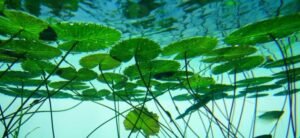
Lily plants, also known as Nymphaea species, are a popular choice for aquarium enthusiasts. They have large, round variegated leaves that create a striking visual impact when they form lily pads. They grow from bulbs and require moderate to high lighting conditions, nutrient-rich substrate, and regular fertilization. They can be propagated by dividing the rhizome or separating and replanting the bulbs. They are best suited for midground to background placement in the aquarium. With proper maintenance, lily plants can transform any aquatic environment into a serene and naturalistic underwater landscape.


